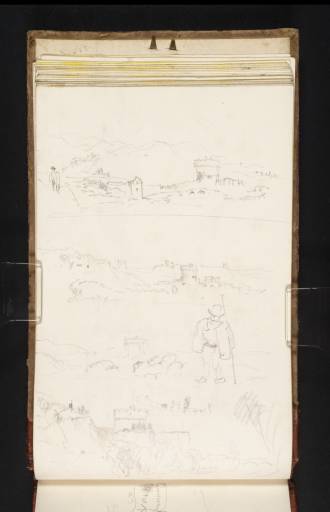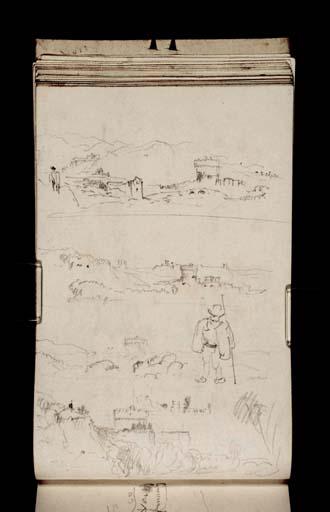Joseph Mallord William Turner Five Views of the Tomb of the Plautii, near Tivoli; and a Sketch of a Man with a Staff 1819
Image 1 of 2
Joseph Mallord William Turner,
Five Views of the Tomb of the Plautii, near Tivoli; and a Sketch of a Man with a Staff
1819
Joseph Mallord William Turner 1775–1851
Folio 27 Verso:
Five Views of the Tomb of the Plautii, near Tivoli; and a Sketch of a Man with a Staff 1819
D14975
Turner Bequest CLXXIX 27 a
Turner Bequest CLXXIX 27 a
Pencil on white wove paper, 186 x 112 mm
Accepted by the nation as part of the Turner Bequest 1856
References
1909
A.J. Finberg, A Complete Inventory of the Drawings of the Turner Bequest, London 1909, vol.I, p.527 as ‘Four views of the Tomb of the Plautii’.
1984
Cecilia Powell, ‘Turner on Classic Ground: His Visits to Central and Southern Italy and Related Paintings and Drawings’, unpublished Ph.D thesis, Courtauld Institute of Art, University of London 1984, p.172 note 10.
1987
Cecilia Powell, Turner in the South: Rome, Naples, Florence, New Haven and London 1987, p.76 note 11.
This page contains five variant views of the Tomb of the Plautius family (or Tomb of the Plautii), a cylindrical first-century funerary monument of Travertine stone, which stands on the Via Valeria, approximately two miles west of Tivoli.1 When travelling on the road from Rome to Tivoli it was one of the first sights to relieve the featureless plain of the Campagna, and, in conjunction with the adjacent Ponte Lucano, it represented a popular subject for artists. Turner would already have been very familiar with the picturesque properties of the site. As a young man, he had copied a watercolour of the tomb from the collection of his patron, Dr Thomas Monro (see Dr Monro’s Album of Italian Views, Tate D36419; Turner Bequest CCCLXXIII 6), and it is possible that he was also familiar with the topographical watercolour view by Louis Ducros (1748–1810) in the collection of Sir Richard Colt Hoare of Stourhead.2 Furthermore, he had also made a thumbnail copy of the relevant plate from John ‘Warwick’ Smith’s Select Views in Italy (1792–9), in the Italian Guide Book sketchbook (see Tate D13966; Turner Bequest CLXXII 19, third from bottom left).
It is not known exactly when Turner made the trip from Rome to Tivoli although Cecilia Powell has speculated that the visit probably took place in early October 1819.3 The twenty-mile journey would have been covered by carriage, however, the large number of sketches of the Ponte Lucano and the Plautian tomb indicate that the artist was afforded enough time to fully explore the site from a number of different angles, on foot as well as from the road. He made over twenty individual views of both the tomb and the bridge, see folios 1 verso, 27 verso–32, 41 verso, 60, 77 and 92 (D14934, D14975–D14984, D15003, D15038, D15071 and D15101), and he also transcribed the Roman inscription commemorating the construction of the Ponte Lucano, see folio 1 (D14933).
On this particular page, Turner has turned his sketchbook vertically in order to fit in several successive drawings showing the bridge and the tomb on the approach from the west (i.e. from Rome). The sketches are swiftly and economically executed but demonstrate a surety of hand and attention to detail. The page also contains a small study of a shepherd or peasant, wearing a jacket and hat and carrying a staff.
Nicola Moorby
January 2010
How to cite
Nicola Moorby, ‘Five Views of the Tomb of the Plautii, near Tivoli; and a Sketch of a Man with a Staff 1819 by Joseph Mallord William Turner’, catalogue entry, January 2010, in David Blayney Brown (ed.), J.M.W. Turner: Sketchbooks, Drawings and Watercolours, Tate Research Publication, December 2012, https://www


